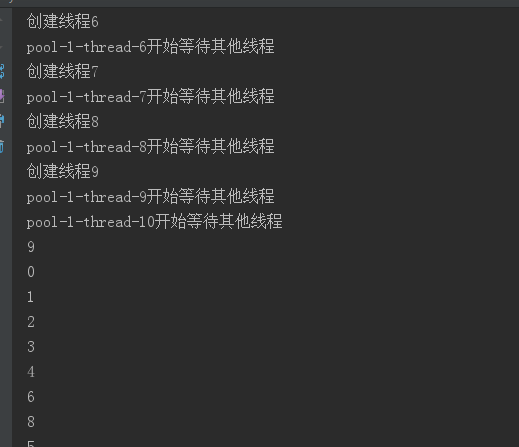CyclicBarrier,一个同步辅助类,在API中是这么介绍的:
它允许一组线程互相等待,直到到达某个公共屏障点 (common barrier point)。在涉及一组固定大小的线程的程序中,这些线程必须不时地互相等待,此时 CyclicBarrier 很有用。因为该 barrier 在释放等待线程后可以重用,所以称它为循环 的 barrier。
通俗点讲就是:让一组线程到达一个屏障时被阻塞,直到最后一个线程到达屏障时,屏障才会开门,所有被屏障拦截的线程才会继续干活。
先可以看下测试结果:

等待线程进来之后并没有立即去执行相关业务逻辑,当线程达到你设计的要求之后才回去执行相关业务逻辑数据,测试代码如下
package com.cxy.cyclicBarrier; import java.util.concurrent.BrokenBarrierException; import java.util.concurrent.CyclicBarrier; import java.util.concurrent.ExecutorService; import java.util.concurrent.Executors; /** * Created by Administrator on 2017/4/10. */ public class CyclicBarrierDemo { private static CyclicBarrier cyclicBarrier=new CyclicBarrier(10); public static void main(String[] args) throws InterruptedException { ExecutorService executorService = Executors.newCachedThreadPool(); for (int i =0;i< 10;i++){ System.out.println("创建线程"+i); final int threadNum =i; Thread.sleep(1000); executorService.execute( ()->{ try { cxyDemo(threadNum); } catch (InterruptedException e) { e.printStackTrace(); } catch (BrokenBarrierException e) { e.printStackTrace(); } }); } executorService.shutdown(); } private static void cxyDemo(int threadNum) throws InterruptedException, BrokenBarrierException { Thread.sleep(1000); System.out.println(Thread.currentThread().getName() + "开始等待其他线程"); cyclicBarrier.await(); System.out.println(threadNum); } }
其中利用到lamba表达式,
利用到可缓存的线程池,可以其中有个注释不是很对
public CyclicBarrier(int parties, Runnable barrierAction) { if (parties <= 0) throw new IllegalArgumentException(); this.parties = parties; this.count = parties; this.barrierCommand = barrierAction; } /** * Creates a new {@code CyclicBarrier} that will trip when the * given number of parties (threads) are waiting upon it, and * does not perform a predefined action when the barrier is tripped. * * @param parties the number of threads that must invoke {@link #await} * before the barrier is tripped * @throws IllegalArgumentException if {@code parties} is less than 1 */ public CyclicBarrier(int parties) { this(parties, null); }
两个构造方法:
第一个需要传入线程数,还有就是Runnable
第二个 需要传入得线程数
这个参数定义的线程数,当线程数到设置的值,那么就回去执行awit方法后面的逻辑
在我上面案例中使用的是第一种构造方法:
下面将使用第二种案例:
package com.cxy.cyclicBarrier; import java.util.concurrent.BrokenBarrierException; import java.util.concurrent.CyclicBarrier; import java.util.concurrent.ExecutorService; import java.util.concurrent.Executors; /** * Created by Administrator on 2017/4/10. */ public class CyclicBarrierDemo { /* private static CyclicBarrier cyclicBarrier=new CyclicBarrier(10); public static void main(String[] args) throws InterruptedException { ExecutorService executorService = Executors.newCachedThreadPool(); for (int i =0;i< 10;i++){ System.out.println("创建线程"+i); final int threadNum =i; Thread.sleep(1000); executorService.execute( ()->{ try { cxyDemo(threadNum); } catch (InterruptedException e) { e.printStackTrace(); } catch (BrokenBarrierException e) { e.printStackTrace(); } }); } executorService.shutdown(); } private static void cxyDemo(int threadNum) throws InterruptedException, BrokenBarrierException { Thread.sleep(1000); System.out.println(Thread.currentThread().getName() + "开始等待其他线程"); cyclicBarrier.await(); System.out.println(threadNum); }*/ private static CyclicBarrier cyclicBarrier; static class CyclicBarrierThread extends Thread { public void run() { System.out.println(Thread.currentThread().getName() + "到了"); //等待 try { cyclicBarrier.await(); } catch (Exception e) { e.printStackTrace(); } } } public static void main(String[] args) { cyclicBarrier = new CyclicBarrier(5, new Runnable() { @Override public void run() { System.out.println("人到齐了,开始吧...."); } }); for (int i = 0; i < 5; i++) { new CyclicBarrierThread().start(); } } }
执行结果:

那么await方法到底干了什么呢:
public int await() throws InterruptedException, BrokenBarrierException { try { return dowait(false, 0L); } catch (TimeoutException toe) { throw new Error(toe); // cannot happen } }
最终调用的dowait方法: /**
* Main barrier code, covering the various policies. */ private int dowait(boolean timed, long nanos) throws InterruptedException, BrokenBarrierException, TimeoutException {
//实现锁,安全 final ReentrantLock lock = this.lock; lock.lock(); try { final Generation g = generation; //分代被破坏,异常抛出 if (g.broken) throw new BrokenBarrierException(); if (Thread.interrupted()) {
//线程被中断, breakBarrier(); throw new InterruptedException(); } //线程进来,减少数据量 int index = --count; if (index == 0) { // tripped
// 达到指定的数量时候,执行
boolean ranAction = false; try { final Runnable command = barrierCommand; if (command != null) command.run();
//唤醒线程 ranAction = true;
//更新分代 nextGeneration(); return 0; } finally { if (!ranAction) breakBarrier(); } } // loop until tripped, broken, interrupted, or timed out for (;;) { try { if (!timed) trip.await(); else if (nanos > 0L) nanos = trip.awaitNanos(nanos); } catch (InterruptedException ie) { if (g == generation && ! g.broken) { breakBarrier(); throw ie; } else { // We're about to finish waiting even if we had not // been interrupted, so this interrupt is deemed to // "belong" to subsequent execution. Thread.currentThread().interrupt(); } } if (g.broken) throw new BrokenBarrierException(); if (g != generation) return index; if (timed && nanos <= 0L) { breakBarrier(); throw new TimeoutException(); } } } finally {
//最终释放锁 lock.unlock(); } }
- 最后一个线程到达,即index == 0
- 超出了指定时间(超时等待)
- 其他的某个线程中断当前线程
- 其他的某个线程中断另一个等待的线程
- 其他的某个线程在等待barrier超时
- 其他的某个线程在此barrier调用reset()方法。reset()方法用于将屏障重置为初始状态
应用场景;开会,还有就是例如现金很火的游戏,只有等待大家准备好了,才开始执行进入房间